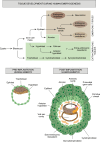Stem cell-based human embryo models: current knowledge and open questions
- PMID: 40877982
- PMCID: PMC12395930
- DOI: 10.1186/s13287-025-04581-2
Stem cell-based human embryo models: current knowledge and open questions
Abstract
Recently, the research field revolving around the stem cell-based modeling of the human embryo gained particular momentum when the first integrated models were designed with the aim to recapitulate the development of the entire early human conceptus. The underlying driving force to reconstruct embryo-like structures is the prospect of a more comprehensive understanding of the fundamental processes controlling early human embryogenesis including their deregulation causing reproductive failures, and the endeavor to use these embryo models for drug testing and disease modeling. Although efforts will continue to create improved models with steadily increasing fidelity to human embryogenesis, the next phase focusing on the application of human embryo models as a platform to address particular scientific questions is currently being entered. In this review, we discuss the benefits, promises and limitations associated with the use of non-integrated and integrated stem cell-based human embryo models in translational research and biomedical applications.
© 2025. The Author(s).
Conflict of interest statement
Declarations. Ethics approval and consent to participate: Not applicable. Consent for publication: Not applicable. Competing interests: The authors have declared that no competing interests exist.
Figures




Similar articles
-
Prescription of Controlled Substances: Benefits and Risks.2025 Jul 6. In: StatPearls [Internet]. Treasure Island (FL): StatPearls Publishing; 2025 Jan–. 2025 Jul 6. In: StatPearls [Internet]. Treasure Island (FL): StatPearls Publishing; 2025 Jan–. PMID: 30726003 Free Books & Documents.
-
Fabricating mice and dementia: opening up relations in multi-species research.In: Jenkins N, Jack-Waugh A, Ritchie L, editors. Multi-Species Dementia Studies. Bristol (UK): Bristol University Press; 2025 Feb 25. Chapter 2. In: Jenkins N, Jack-Waugh A, Ritchie L, editors. Multi-Species Dementia Studies. Bristol (UK): Bristol University Press; 2025 Feb 25. Chapter 2. PMID: 40690569 Free Books & Documents. Review.
-
Moving toward totipotency: the molecular and cellular features of totipotent and naive pluripotent stem cells.Hum Reprod Update. 2025 Jul 1;31(4):361-391. doi: 10.1093/humupd/dmaf006. Hum Reprod Update. 2025. PMID: 40299455 Review.
-
Healthcare workers' informal uses of mobile phones and other mobile devices to support their work: a qualitative evidence synthesis.Cochrane Database Syst Rev. 2024 Aug 27;8(8):CD015705. doi: 10.1002/14651858.CD015705.pub2. Cochrane Database Syst Rev. 2024. PMID: 39189465 Free PMC article.
-
Stem cell-based embryo models: The 2021 ISSCR stem cell guidelines revisited.Stem Cell Reports. 2025 Jun 10;20(6):102514. doi: 10.1016/j.stemcr.2025.102514. Stem Cell Reports. 2025. PMID: 40499509 Free PMC article. Review.
References
-
- Molè MA, Weberling A, Zernicka-Goetz M. Comparative analysis of human and mouse development: from zygote to pre-gastrulation. Curr Top Dev Biol. 2020;136:113–38. - PubMed
-
- Pereira Daoud AM, Popovic M, Dondorp WJ, Trani Bustos M, Bredenoord AL, Chuva de Sousa Lopes SM, et al. Modelling human embryogenesis: embryo-like structures spark ethical and policy debate. Hum Reprod Update. 2020;26:779–98. - PubMed
-
- Rossant J, Tam PPL. Early human embryonic development: blastocyst formation to gastrulation. Dev Cell. 2022;57:152–65. - PubMed
Publication types
MeSH terms
LinkOut - more resources
Full Text Sources

